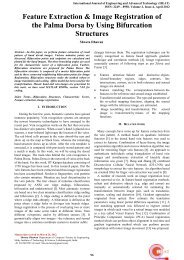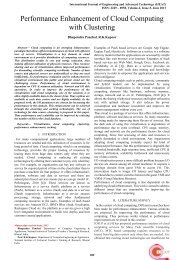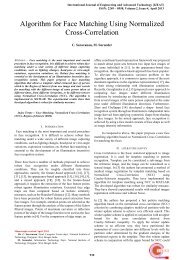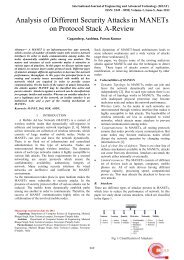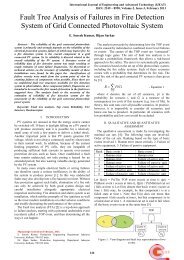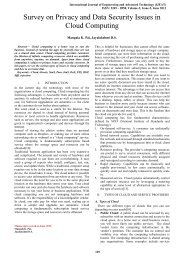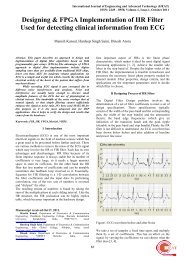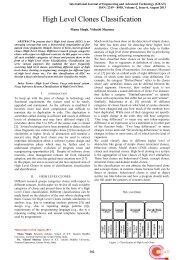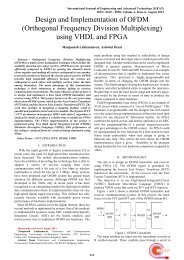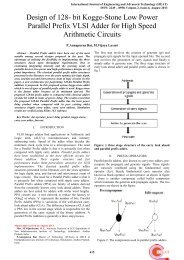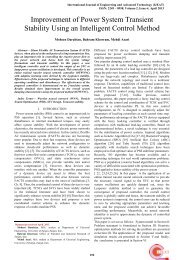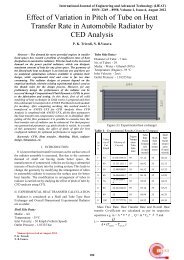Series-Connected ForwardâFlyback Converter for High Step-Up ...
Series-Connected ForwardâFlyback Converter for High Step-Up ...
Series-Connected ForwardâFlyback Converter for High Step-Up ...
Create successful ePaper yourself
Turn your PDF publications into a flip-book with our unique Google optimized e-Paper software.
International Journal of Engineering and Advanced Technology (IJEAT)<br />
ISSN: 2249 – 8958, Volume-2, Issue-2, December 2012<br />
Aswathy.P.S,M.S.P.Subathra<br />
Abstract— Global energy consumption tends to grow<br />
continuously. To satisfy the demand <strong>for</strong> electric power against a<br />
background of the depletion of conventional, fossil resources the<br />
renewable energy sources are becoming more popular.According<br />
to the researches despite its fluctuating nature and weather<br />
dependency the capacity of renewable resources can satisfy overall<br />
global demand <strong>for</strong> energy. <strong>High</strong> gain DC/DC converters are the<br />
key part of renewable energy systems .The designing of high gain<br />
DC/DC converters is imposed by severe demands. The power<br />
conditioning systems <strong>for</strong> the photovoltaic power sources needs<br />
high step-up voltage gain due to the low output of the generating<br />
sources. This paper presents a high step-up topology employing a<br />
<strong>Series</strong>-connected Forward-FlyBack converter, which has a seriesconnected<br />
output <strong>for</strong> high boosting voltage-transfer gain. <strong>Series</strong>connected<br />
Forward-FlyBack converter is a hybrid type of <strong>for</strong>ward<br />
and flyback converter. By stacking the outputs of them extremely<br />
high voltage gain can be obtained with small volume and high<br />
efficiency with a galvanic isolation. The separated secondary<br />
windings reduce the voltage stress of the secondary rectifiers and<br />
results in high efficiency.<br />
Keywords—DC-DC power converters, <strong>for</strong>ward converter,<br />
flybackconverter, power conditioning.<br />
I. INTRODUCTION<br />
The renewable energy sources such as PV modules, energy<br />
storage devices such as super capacitors or batteries deliver<br />
output voltage at the range of around 10 to 80 VDC. In order<br />
to connect them to the grid the voltage level should be<br />
adjusted according to the electrical network standards in the<br />
countries. Solar array can be installed on top of commercial<br />
buildings or residential houses in urban area.The small-scale<br />
generator has been developed under a modularizing concept<br />
because the power capacity extension of the system is quite<br />
easy by standardized photovoltaic (PV)modules [15]<br />
compared to some large-scale centralized photovoltaic power<br />
generation systemsFrom the perspective of the small scale<br />
power systems, some accommodated schemes such as ―ac<br />
module‖ and ―module-integrated converter‖ have emerged.<br />
AC module is a photovoltaic module including a small ac<br />
inverter with no external dc connector.Module integrated<br />
converter is more a general concept including a few<br />
series/parallel-connected dc–dc converter modules with a<br />
centralized inverter.<br />
Manuscript Received on December,2012.<br />
Aswathy.P.S, Electricaland Electronics Engineering, Karunya University,<br />
Coimbatore, Tamilnadu, India.<br />
M.S.P.Subathra, Electrical and Electronics Engineering, Karunya<br />
University, Coimbatore, Tamilnadu, India.<br />
With the advent of extremely distributed small scale energy<br />
sources that have high-power generation efficiency even with<br />
partial shading. Occurrence, extremely high voltage boost<br />
gain is required from the power conditioners. Since the<br />
output from a typical small scale solar array is very low<br />
there<strong>for</strong>e a high step-up dc–dc converter is necessary <strong>for</strong> the<br />
grid-connected power conditioning systems.<br />
Though there are some existing topologies applicable to<br />
such high voltage-boost power converters, such as softswitching<br />
converters where a coupled inductor is applied or<br />
switched capacitor manner, they have poor reliability due to<br />
the absence of isolation. An isolation type converter has an<br />
advantage of the safety and system reliability, in spite of<br />
high power conversion efficiency. There<strong>for</strong>e, many emerging<br />
applications including renewable energy conditioner<br />
demands the isolation requirement in their design<br />
specification.<br />
For insulation, the use of a magnetic-coupled trans<strong>for</strong>mer<br />
[3] is essential. However, this requires a reset circuit that has<br />
disadvantages in per<strong>for</strong>mance and cost, resulting in the<br />
difficulty of circuit design. This reset also has loading effect<br />
by its impedance, which increases the voltage stresses of the<br />
switching devices and the turn ratio of the main trans<strong>for</strong>mer.<br />
Conventional research has suggested some solutions <strong>for</strong> highpower<br />
high-boost applications.<br />
In this paper, an output-series <strong>for</strong>ward–flyback (SFFB) dc–<br />
dc switching converter has been suggested, which serially<br />
connects the secondary outputs of a multiwinding <strong>for</strong>ward–<br />
flyback converter in order to solve these isolation-type<br />
disadvantages. However, the conventional <strong>for</strong>ward–flyback<br />
converters are confined to power factor collection circuit<br />
applications where multiple outputs or paralleled outputs are<br />
used.The dc–dc converter resolved the engineering problems<br />
of large voltage enhancement issue such as manufacturing<br />
cost and low reliability, which had been pointed out as a<br />
problem of the various conventional circuit topologies. At the<br />
same time, the proposed scheme improves the weaknesses of<br />
insulation-type converters, such as low efficiency, big<br />
volume, and high cost, by utilizing the structure of the<br />
<strong>for</strong>ward–flyback converter.<br />
The step up converter has a reduced voltage rating of<br />
rectifying diodes by separating secondary winding. The<br />
extremely high enhancement gain is also separated by the<br />
attenuated boost conversion of <strong>for</strong>ward converter and<br />
flybackconverter,thus the device stress is reduced and the<br />
power efficiency is improved. Also, a utilization factor of the<br />
trans<strong>for</strong>mer is highly enhanced up bycontinuous power<br />
delivery from primary to secondary which contributes to the<br />
reduced volume of the <strong>for</strong>ward–flyback converter.<br />
269
<strong>Series</strong>-<strong>Connected</strong> Forward–Flyback <strong>Converter</strong> <strong>for</strong> <strong>High</strong> <strong>Step</strong>-<strong>Up</strong> Power Conversion<br />
Fig.1Conventional <strong>for</strong>ward–flyback power converters. (a)<br />
Double winding <strong>for</strong>ward–flyback converter. (b) Triplewinding<br />
parallel-output <strong>for</strong>ward–flyback converter.<br />
Though there are some existing topologies applicable to<br />
such high voltage-boost power converters, such as softswitching<br />
converters where a coupled inductor is applied or<br />
switched capacitor manner, they have poor reliability due to<br />
the absence of isolation. On the other hand, an isolation type<br />
converter has an advantage of the safety and system<br />
reliability, in spite of the high power conversion efficiency.<br />
There<strong>for</strong>e, many emerging applications including renewable<br />
energy conditioner demands the isolation requirement in their<br />
design specification. For insulation, the use of a magneticcoupled<br />
trans<strong>for</strong>mer is essential.However,this requires a reset<br />
circuit that has disadvantages in per<strong>for</strong>mance and cost,<br />
resulting in the difficulty of circuit design. This reset also has<br />
loading effect by its impedance, which increases the voltage<br />
stresses of the switching devices and the turn ratio of the<br />
main trans<strong>for</strong>mer. Conventional research has suggested some<br />
solutions <strong>for</strong> high-power high-boost applications; however,<br />
still there are material cost and design<br />
II. SERIES CONNECTED FORWARD FLY BACK<br />
CONVERTER<br />
In this paper, an output-series <strong>for</strong>ward–flyback (SFFB) dc–<br />
dc switching converter has been suggested, which serially<br />
connects the secondary outputs of a multiwinding <strong>for</strong>ward–<br />
flyback converter in order to solve these isolation-type<br />
disadvantages. Forward–flyback converters deliver the<br />
required energy to the load through a trans<strong>for</strong>mer no matter<br />
when the main switch turns ON or OFF, holding an<br />
advantage in terms of supplying more power to the load than<br />
any other single-ended isolation schemes does at the same<br />
volume.<br />
However, the conventional <strong>for</strong>ward–flyback converters<br />
are confined to power factor collection circuit applications<br />
where multiple outputs or paralleled outputs are used [14].<br />
The dc–dc converter resolved the engineering problems of<br />
large voltage enhancement issue such as manufacturing cost<br />
and low reliability, which had been pointed out as a problem<br />
of the various conventional circuit topologies. At the same<br />
time, the proposed scheme improves the weaknesses of<br />
insulation-type converters, such as low efficiency, big<br />
volume, and high cost, by utilizing the structure of the<br />
<strong>for</strong>ward–flyback converter. Technically, the suggested high<br />
step-up converter has a reduced voltage rating of rectifying<br />
diodes by separating secondary winding. The extremely high<br />
enhancement gain is also separated by the attenuated boost<br />
conversion of <strong>for</strong>ward converter and flyback converter<br />
thus,the device stress is reduced and the power efficiency is<br />
improved. Also, a utilization factor of the trans<strong>for</strong>mer is<br />
highly enhanced up by continuous power delivery from<br />
primary to secondary which contributes to the reduced<br />
volume of the <strong>for</strong>ward–flyback converter.<br />
A. Structure of a SFFB <strong>Converter</strong><br />
The structure of the proposed dc–dc converter is shown in<br />
Fig.6.The primary has a pulse width modulation (PWM)<br />
switching voltages occurred by a single main switch. The<br />
secondary is a structure where the <strong>for</strong>ward converter and the<br />
flyback converter are separated by trans<strong>for</strong>mer winding.<br />
However, the outputs are serially connected <strong>for</strong> the output<br />
voltage boost. Since the single-ended structure of the<br />
proposed converter is suitable <strong>for</strong> small power capacity<br />
compared to other bridge type topologies, it mostly has a low<br />
current level over high output voltage, allowing a<br />
discontinuous conduction mode (DCM) to be easily<br />
implemented. In addition, the elimination of reverse recovery<br />
current of diodes in DCM has advantages in terms of power<br />
efficiency.<br />
Fig. 6 Circuit diagram of the proposed SFFB converter.<br />
B. Operating Principles<br />
The proposed converter has four operating modes as shown<br />
in Fig. 7, according to the switching state of switching<br />
circuits.<br />
Mode 1: Current flows to the magnetizing inductance and<br />
the primary winding Np as a result of turning ON switch Q.<br />
The primary current is transferred to the secondary Nfw coil<br />
of the <strong>for</strong>ward converter via the magnetic linkage. Then, the<br />
ac power is rectified into dc which load requires through a<br />
<strong>for</strong>ward diode Dfw and a low-pass filter Lout and Cfw .Since<br />
270
a flyback diode Dfb is reverse biased,the capacitor C0<br />
provides the load current during this mode.<br />
Mode 2: When switch Q is turned OFF, a <strong>for</strong>ward diode<br />
Dfw is reverse biased and the energy stored in Lout is<br />
transferred to the load by the freewheeling current via Dff ,<br />
and at the same time, the energy magnetically stored at Lm is<br />
also supplied to load through Dfb of the flyback converter.<br />
Thus, all the freewheeling current in magnetic devices<br />
decreases linearly.<br />
Mode 3: The <strong>for</strong>ward converter starts to operate in DCM<br />
when all the energy in Lout is discharged, and then a<br />
freewheeling diode Dff is reverse biased. The energy only<br />
stored in Lm is supplied to load through the flyback<br />
converter.<br />
Mode 4: The trans<strong>for</strong>mer of the <strong>for</strong>ward–flyback converter<br />
is demagnetized completely during this period and the output<br />
voltage is maintained by the discharge of the output<br />
capacitors Cfw and Cfb. All the rectifier diodes are reverse<br />
biased.<br />
International Journal of Engineering and Advanced Technology (IJEAT)<br />
ISSN: 2249 – 8958, Volume-2, Issue-2, December 2012<br />
Fig 7 Working Principle<br />
III. DESIGN GUIDELINES<br />
Key design parameters of the proposed SFFB converter are<br />
trans<strong>for</strong>mer core and windings, MOSFET and diodes,<br />
<strong>for</strong>ward inductor and output capacitors, etc<br />
A. Analysis of the Optimal Trans<strong>for</strong>mer Turn Ratio<br />
For high efficiency without core saturation,Kn= 0.4 With<br />
the selected Kn, the winding number is chosen as Np: Nfw :<br />
Nfb = 20 : 150 : 60. Critical magnetizing inductance <strong>for</strong><br />
DCM is derived as<br />
B. Forward’s Filter Inductor<br />
271
<strong>Series</strong>-<strong>Connected</strong> Forward–Flyback <strong>Converter</strong> <strong>for</strong> <strong>High</strong> <strong>Step</strong>-<strong>Up</strong> Power Conversion<br />
The maximum filter inductance of the <strong>for</strong>ward’s output is<br />
determined as<br />
The inductance utilized in the hardware prototype DCM is<br />
Lout = 1.7mH.<br />
C. MOSFET and Diodes<br />
The voltage stress is derived as<br />
VDS_ max = Vin_ max (1 + n2) = 77.8 V<br />
The secondary-diode selection should consider voltage and<br />
current stresses, reverse recovery characteristics, etc. Voltage<br />
stresses of the <strong>for</strong>ward, freewheeling, and flyback diodes are,<br />
respectively, shown in<br />
flyback converter are separated by trans<strong>for</strong>mer winding.<br />
However, the outputs are serially connected <strong>for</strong> the output<br />
voltage boost. Since the single-ended structure of the<br />
proposed converter is suitable <strong>for</strong> small power capacity<br />
compared to other bridge-type topologies, it mostly has a low<br />
current level over high output voltage, allowing a<br />
discontinuous conduction mode (DCM) to be easily<br />
implemented. In addition, the elimination of reverse recovery<br />
current of diodes in DCM has advantages in terms of power<br />
efficiency.Next,the simulation of the proposed circuit to<br />
obtain an output of 340V, which is shown in the fig. 8<br />
followed by the simulation resultsin fig. 9<br />
IV. SIMULATION<br />
The tools used <strong>for</strong> computer simulation is PSIM. <strong>Step</strong>s<br />
involved in simulation are<br />
1. Simulation of <strong>for</strong>ward converter.<br />
2. Simulation of flyback converter.<br />
3. Simulationof the series connected <strong>for</strong>ward flyback<br />
converter.<br />
Table 1 Output specifications<br />
Fig 8 simulation diagram of proposed circuit<br />
Input voltage<br />
20-40 V<br />
Output voltage<br />
340 V<br />
Output power<br />
100 W<br />
Switching frequency<br />
20 KHz<br />
Magnetizing inductance<br />
246 uH<br />
Forward’s output<br />
inductance<br />
1.7 m H<br />
Fig 9 simulation results of the proposed circuit<br />
<strong>Series</strong> connected <strong>for</strong>ward flyback converter is a dc– dc<br />
converter, which serially connects the secondary outputs of a<br />
multiwinding <strong>for</strong>ward–flyback converter in order to solve<br />
these isolation-type disadvantages.Forward–flyback<br />
converters deliver the required energy to the load through a<br />
trans<strong>for</strong>mer no matter when the main switch turns ON or<br />
OFF, holding an advantage in terms of supplying more power<br />
to the load than any other single-ended isolation schemes<br />
does at the same volume.<br />
The primary has a pulse width modulation (PWM)<br />
switching voltages occurred by a single main switch. The<br />
secondary is a structure where the <strong>for</strong>ward converter and the<br />
V. CONCLUSION<br />
In this paper, a preregulating dc–dc converter of an series<br />
connected <strong>for</strong>ward fly back converter <strong>for</strong> multistage PV<br />
power conditioning systems has been proposed. SFFB is a<br />
hybrid type of <strong>for</strong>ward and flybackconverter,sharing a<br />
trans<strong>for</strong>mer <strong>for</strong> increasing the utilization factor. By stacking<br />
the outputs of them,high voltage gain can be obtained with<br />
small volume and high efficiency.The separated secondary<br />
windings in low turn-ratio reduce the voltage stress of the<br />
secondary rectifiers and thus high efficiency can be<br />
achieved.The high voltage, low-current output has a filter<br />
inductor under DCM operation that contributes to better<br />
272
per<strong>for</strong>mances by eliminating reverse recovery of the<br />
rectifying diodes .As a future work, it will be worthwhile to<br />
obtain the softswitching operation in extremely step-up<br />
applications <strong>for</strong> the more various specifications such as highfrequency<br />
applications, high or low voltage or current<br />
applications.<br />
VI. REFERENCES<br />
[1] Jong-Hyun Lee, Joung-Hu Park, Jeon.J.H.(2011),‖<strong>Series</strong>-<strong>Connected</strong><br />
Forward–Flyback <strong>Converter</strong> <strong>for</strong> <strong>High</strong> <strong>Step</strong>-<strong>Up</strong> Power Conversion‖,<br />
IEEE transactions on power electronics, vol. 26, no. 12.<br />
[2] Choi.W,Kim.S, Park.S, Kim.K, and Lim.Y,(2009),‖<strong>High</strong> <strong>Step</strong> up<br />
dc/dc <strong>Converter</strong> with <strong>High</strong> Efficiency <strong>for</strong> Photovoltaic Module<br />
Integrated <strong>Converter</strong> Systems‖,31 st Int. Telecomm.Energy Conf.<br />
(INTELEC) IEEE 1, CD-ROM<br />
[3] Colonel W. T. McLyman, (2002), ―<strong>High</strong> Reliability Magnetic<br />
Devices‖. Boca Raton, FL: CRC Press.[4]Delshad.M and<br />
Farzanehfard.H,(2008),‖<strong>High</strong> <strong>Step</strong>-up Zero-voltage Switching<br />
Current-fed Isolated Pulse Width Modulation DC–DC <strong>Converter</strong>‖,<br />
IETJ.IEEE1,316–322<br />
[5] Fairchild Semiconductor.(2003). AN4134, Design Guidelines For<br />
Off-line Forward <strong>Converter</strong>s using Fairchild Power Switch.<br />
[6] Chen.Y, H.-C. Wu,Y.- C. Chen, K.-Y. Lee,and S.-S. Shyu,( Jan.<br />
2010.),‖The AC line Current Regulation Strategy <strong>for</strong> the Gridconnected<br />
PV System‖,IEEETrans. Power Electron, vol. 25, no. 1, pp.<br />
209–218,<br />
[7] Itoher.A,Meyer.T, and Nagel.A, (1996),‖A New Panel-Integratable<br />
Inverter Concept <strong>for</strong> Grid-<strong>Connected</strong> photovoltaic systems‖, Int.<br />
Symp. On yIndust.Electronics(ISIE) IEEE<br />
[8] Lee.S,.Kim.J.E, and Cha.H, (2010),‖Design and Implementation of<br />
Photovoltaic Power Conditioning System using a Current-based<br />
Maximum Power Point Tracking‖,J. Electr. Eng. Technol., vol. 5, pp.<br />
606–613,<br />
[9] Lee1.J,Han1.B,Choi.K, (2011),‖<strong>High</strong>-Efficiency Grid-Tied Power<br />
Conditioning System <strong>for</strong> Fuel Cell Power Generation‖ 8th<br />
International Conference on Power Electronics ,May 30-June<br />
[10] Li.Q and Wolfs.P, (2002),―An Analysis of a Resonant Half Bridge<br />
Dual <strong>Converter</strong> Operating in Continuous and Discontinuous<br />
Modes‖,33rd Annual Power Electronics Specialists Conf. (PESC)<br />
IEEE1, 1313–1318<br />
[11] Ma.M, Wi.L, Deng.Y, and He.X, (2010),‖A Non-isolated <strong>High</strong> <strong>Step</strong>up<br />
<strong>Converter</strong> with Built-in Trans<strong>for</strong>mer Derived from its Isolated<br />
Counterpart‖, 36th Annual Conf. on IEEE Indust. Electronics<br />
Society (IECON) IEEE 1, 3173–3178<br />
[12] Park.J.H, Ahn.J.Y,ChoB.H, and Yu.G.J,(2006),‖Dual-module-Based<br />
Maximum Power Tracking Control of Photovoltaic Systems‖IEEE<br />
Trans.Power Electron., vol. 53, no. 4, pp. 1036–1047,<br />
[13] Tacca.H,(2000),―Power Factor Correction Using Merged Flyback<strong>for</strong>ward<br />
<strong>Converter</strong>s‖,IEEE Trans. Power Electron., vol. 15, no. 4, pp.<br />
585–594, Jul.<br />
[14] Tacca.H,(2000),―Flyback vs. Forward <strong>Converter</strong> Topology<br />
Comparison Based <strong>Up</strong>on Magnetic Design Criterion‖, in Proc.<br />
Potencia, Revista de la SOBRAEP—MISSN 1414-8862, Brazil,<br />
[15] Yang.B,Li.W, Zhao.Y, and He.X,( 2010),‖Design and Analysis of a<br />
Grid connected Photovoltaic Power System‖, IEEE Trans. Power<br />
Electron,vol. 25, no. 4, pp. 992–1000<br />
Aswathy.p.s was born in kerala.she completed her B.tech<br />
from cohin university of science and technology.she is<br />
doing her master’s degree in power electronics and drives<br />
from karunya university<br />
International Journal of Engineering and Advanced Technology (IJEAT)<br />
ISSN: 2249 – 8958, Volume-2, Issue-2, December 2012<br />
M.S.P subathra is currently working as an assistant<br />
professor(S G) in karunya university Coimbatore.She<br />
completed her B.E(1997) and M.E (power system<br />
engineering 1995) from thiagarajar college of engineering<br />
Madurai ramaraj university. She presented several national<br />
and international papers.<br />
273



